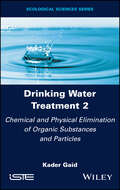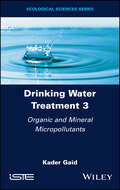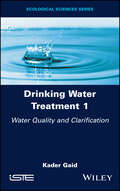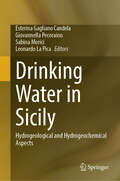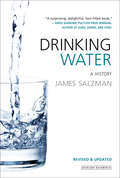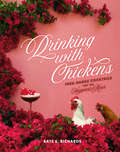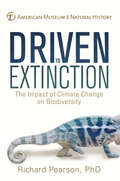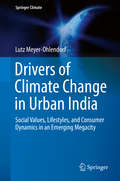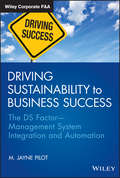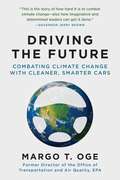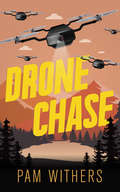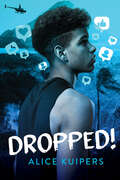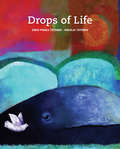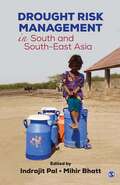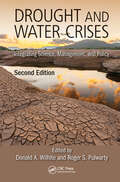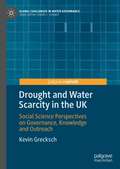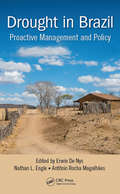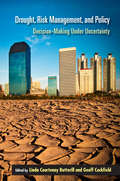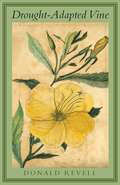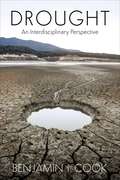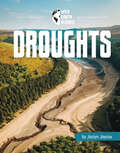- Table View
- List View
Drinking Water Treatment, Chemical and Physical Elimination of Organic Substances and Particles
by Kader GaidToday, hundreds of millions of people drink contaminated water without knowing it. Yet water treatment technologies can effectively eliminate contamination and can supply urban and rural populations with safe drinking water in a secure way.For almost two centuries, the huge number of treatments available to guarantee water quality has grown alongside technological progress, the strengthening of industry norms and the reinforcement of consumer expectations. New treatment methods have been developed according to the advancement of knowledge and new sanitary regulations.This five-volume book sets out to clearly present the variety of treatments available along with their performance, limitations and conditions of use as well as ways to combine them to produce safe drinking water, which is a basic need essential to everyday life.The author shares his expertise acquired at Veolia, a company that is a world leader in water services and sanitation, desalination of sea water and the recycling of wastewater. Founded in France in 1853 to bring safe water to populations and to protect them from waterborne epidemics which ravaged cities, its history is intertwined with that of water treatment.
Drinking Water Treatment, Membranes Applied to Drinking Water and Desalination
by Kader GaidToday, hundreds of millions of people drink contaminated water without knowing it. Yet water treatment technologies can effectively eliminate contamination and can supply urban and rural populations with safe drinking water in a secure way. For almost two centuries, the huge number of treatments available to guarantee water quality has grown alongside technological progress, the strengthening of industry norms and the reinforcement of consumer expectations. New treatment methods have been developed according to the advancement of knowledge and new sanitary regulations. This five-volume book sets out to clearly present the variety of treatments available along with their performance, limitations and conditions of use as well as ways to combine them to produce safe drinking water, which is a basic need essential to everyday life. The author shares his expertise acquired at Veolia, a company that is a world leader in water services and sanitation, desalination of sea water and the recycling of wastewater. Founded in France in 1853 to bring safe water to populations and to protect them from waterborne epidemics which ravaged cities, its history is intertwined with that of water treatment.
Drinking Water Treatment, Organic and Mineral Micropollutants
by Kader GaidToday, hundreds of millions of people drink contaminated water without knowing it. Yet water treatment technologies can effectively eliminate contamination and can supply urban and rural populations with safe drinking water in a secure way. For almost two centuries, the huge number of treatments available to guarantee water quality has grown alongside technological progress, the strengthening of industry norms and the reinforcement of consumer expectations. New treatment methods have been developed according to the advancement of knowledge and new sanitary regulations. This five-volume book sets out to clearly present the variety of treatments available along with their performance, limitations and conditions of use as well as ways to combine them to produce safe drinking water, which is a basic need essential to everyday life. The author shares his expertise acquired at Veolia, a company that is a world leader in water services and sanitation, desalination of sea water and the recycling of wastewater. Founded in France in 1853 to bring safe water to populations and to protect them from waterborne epidemics which ravaged cities, its history is intertwined with that of water treatment.
Drinking Water Treatment, Water Quality and Clarification
by Kader GaidToday, hundreds of millions of people drink contaminated water without knowing it. Yet water treatment technologies can effectively eliminate contamination and can supply urban and rural populations with safe drinking water in a secure way. For almost two centuries, the huge number of treatments available to guarantee water quality has grown alongside technological progress, the strengthening of industry norms and the reinforcement of consumer expectations. New treatment methods have been developed according to the advancement of knowledge and new sanitary regulations. This five-volume book sets out to clearly present the variety of treatments available along with their performance, limitations and conditions of use as well as ways to combine them to produce safe drinking water, which is a basic need essential to everyday life. The author shares his expertise acquired at Veolia, a company that is a world leader in water services and sanitation, desalination of sea water and the recycling of wastewater. Founded in France in 1853 to bring safe water to populations and to protect them from waterborne epidemics which ravaged cities, its history is intertwined with that of water treatment.
Drinking Water in Sicily: Hydrogeological and Hydrogeochemical Aspects
by Esterina Gagliano Candela Giovannella Pecoraino Sabina Morici Leonardo La PicaThis book consists of the hydrogeochemical study of the springs of the Sicilian territory used for drinking water purposes. One of the most important issues in the environmental field is the protection of water resources and in particular the safeguarding of water intended for drinking water use. Water resources need a careful prevention of pollution starting from multidisciplinary studies (geology, hydrogeology, geochemistry, geophysics) to understand the territory in order to highlight vulnerable areas and then plan, where necessary, monitoring activities for the control and protection of the resource. The reference is the Piano Regolatore degli Acquedotti (PRGA) of Sicily, Italy (updated in November 2010), which lists all the springs, subdivided by province (a total of 1014), currently used to supply water to Sicilian aqueducts. With regard to the geochemical part, the studies carried out by the INGV, Sezione di Palermo, for the Water Protection Plan for Sicily (2004-2005) were used as basic data. The study of the chemical characteristics of groundwater is of fundamental importance from a hydrogeological point of view as it allows the origin of the water and its evolution to be reconstructed. Springs as a groundwater resource are of considerable importance in relation to the availability of water resources due to the general decrease in precipitation. In the first part of the book all the existing data (flow rates, geochemical parameters, water quality, etc.) are collected and subsequently transferred to GIS software, after appropriate evaluations on the validity of the acquired data. Considering that the subject is quite delicate and involves various aspects (compliance with regulations, vulnerability of groundwater, anthropogenic pollution, etc.), carrying out a purely scientific study allows groundwater to be placed in a broader context than that of legislation aimed exclusively at compliance with the regulations in force.
Drinking Water: A History
by James SalzmanAn in-depth look at the changing approaches that environmentalists, governments, and the open market have taken to water through the lens of world history. When we turn on the tap or twist open a tall plastic bottle, we probably don&’t give a second thought about where our drinking water comes from. But how it gets from the ground to the glass is far more convoluted than we might think. In this revised edition of Drinking Water, Duke University professor and environmental policy expert James Salzman shows how drinking water highlights the most pressing issues of our time. He adds eye-opening, contemporary examples about our relationship to and consumption of water, and a new chapter about the atrocities that occurred in Flint, Michigan. Provocative, insightful, and engaging, Drinking Water shows just how complex a simple glass of water can be.&“A surprising, delightful, fact-filled book.&” —Jared Diamond, Pulitzer Prize–winning author of Guns, Germs, and Steel &“Instead of buying your next twelve-pack of bottled water, buy this fascinating account of all the people who spent their lives making sure you&’d have clean, safe drinking water every time you turned on the tap.&” —Bill McKibben, author of Earth: Making a Life on a Tough New Planet &“Drinking Water effortlessly guides us through a fascinating world we never consider. Even for people who think they know water, there is a surprise on almost every page.&” —Charles Fishman, bestselling author of The Big Thirst and The Wal-Mart Effect &“Salzman puts a needed spotlight on an often overlooked but critical social, economic, and political resource.&” —Publishers Weekly
Drinking with Chickens: Free-Range Cocktails for the Happiest Hour
by Kate E. RichardsIt's drinks, it's chickens: It's the cocktail book you didn't know you needed!To add some extra happy to your happy hour , invite a chicken and pour yourself a drink. Author Kate Richards serves up cocktails made for Instagram with the spoils of her Southern California garden, chicken friends by her side. Enjoy any (or all) of the 60+ deliciously drinkable garden-to-glass beverages, such as:Lilac Apricot Rum Sour Meyer Lemon + Rosemary Old Fashioned Rhubarb Rose Cobbler Blackberry Sage Spritz Cantaloupe Mint Rum PunchCocktails are arranged seasonally, and are 100% accessible for those of us without perpetually sunny backyard gardens at our disposal. Drinking with Chickens will quickly become a boozy favorite, perfect for gifting or for hoarding all for yourself. You don't need chickens to enjoy these drinks or the colorful photos, but be careful, because you may even find yourself aspiring to be, as Kate is, a home chixologist overrun by gorgeous, loud, early-rising egg-laying ladies, and in need of a very strong drink.
Driven by Demand: How Energy Gets its Power
by Jimmy Y. Jia Jason CrabtreeEnergy plays a central role in shaping our society and infrastructure, making it increasingly important for today's leaders to understand the impact of energy decisions. Discussions about energy often neglect important historical lessons about previous energy transformations and provide inadequate consideration of context - Driven by Demand takes a fresh approach by exploring the emergence of energy systems, outcomes and priorities. It outlines select historical and current events, challenges, and developing energy trends using a range of case studies. Readers will gain foundational knowledge about energy flows and end-uses, helping them to become more conversant about energy outcomes and priorities. This accessible book paves the way for broader discussions about societal resilience, privacy, and security concerns associated with the move towards 'smart' infrastructure. This is a must-read for business executives, policymakers and students working in energy policy, energy management and sustainable business.
Driven to Extinction: The Impact of Climate Change on Biodiversity
by American Museum of Natural History Richard PearsonCould more than a million species disappear in the 21st century? Written by a leading scientist in the field, Driven to Extinction draws upon fascinating case studies from around the world, providing balanced and well-reasoned insight into the potential impacts of climate change on the diversity of life. Richard Pearson focuses on the science of the issue, revealing what has happened––as well as what is likely to happen––to some of the worlds weirdest and most wonderful species as global temperatures continue to rise.
Drivers of Climate Change in Urban India: Social Values, Lifestyles, and Consumer Dynamics in an Emerging Megacity (Springer Climate)
by Lutz Meyer-OhlendorfThis study transcends the homogenizing (inter-)national level of argumentation (‘rich’ versus ‘poor’ countries), and instead looks at a sub-national level in two respects: (1) geographically it focuses on the rapidly growing megacity of Hyderabad; (2) in socio-economic terms the urban population is disaggregated by taking a lifestyle typology approach. For the first time, the lifestyle concept – traditionally being used in affluent consumer societies – is applied to a dynamically transforming and socially heterogeneous urban society. Methodically, the author includes India-specific value orientations as well as social practices as markers of social structural differentiation. The study identifies differentials of lifestyle-induced GHG emissions (carbon footprints) and underlines the ambiguity of a purely income based differentiation with regard to the levels of contribution to the climate problem.
Driving Sustainability to Business Success
by M. Jayne PilotEfficient, compliant management systems pave the road to sustainability through integration and automationThe book addresses the many definitions of sustainability and why CEOs need the links between sustainability, business value, and performance. Business leaders are committed to leading the way, and the book outlines the support of a management system structure and business principles that will drive the accomplishment of their mission. Stakeholder demands on CEOs include many challenges. Investors are assessing companies for financial performance. The shrinking talent pool of employees is looking to work with organizations that support social, environment, and economic operating practices and principles.Great leaders are those that ask questions, who are creative to drive innovation for growth of their company. The Assess-Reflect-Act section on international business principles defined in the book will ask you as the leader thought provoking questions to stimulate action within your organization to bring people, processes, and technology together for business success.Leaders need to transition to smart decisions that are data driven. The company's management system structure is important to build a strong framework for business process operations and automation for global competitiveness. Topics include:Business plans vs management systemsManagement system frameworks: standardization, ISO standards: Quality -- ISO 9001, Environment -- ISO 14001, OHSAS 18001, Integrated Management SystemsThree Steps for Process Development: Identify, Insure, ImproveFocus for the Organization: Compliance Costs, Best Practices, Strategic PlanningSupport -- Resources: Innovation, Engagement, Succession PlanningData as a Valuable ResourceOperation: Process Risks, Management System Control Plan, E-commerce, Enterprise Resource Planning (ERP), Green Awareness-Eco Design, Automated Controls, Cloud ComputingPerformance Evaluation -- Monitor, Measure, Analyze, Audit, Management ReviewCompetitive LandscapeThe constant need to improve internal processes and move toward business sustainability and quality standards is a major stressor for governments and businesses. With one-third of the workforce retiring in the next five to ten years, the need has become more immediate, and the focus has shifted to building a strong framework for business process operations and automation for global competitiveness. This book provides a roadmap to efficient, compliant systems, showing businesses how to build toward sustainability goals and capture key knowledge of the employees involved in the process.
Driving the Future: Combating Climate Change with Cleaner, Smarter Cars
by Fred Krupp Margo T OgeNow in paperback, with a new foreword by Fred Krupp, an expert's illuminating preview of the cleaner, lighter, smarter cars of the future.In Driving the Future, Margo T. Oge portrays a future where clean, intelligent vehicles with lighter frames and alternative power trains will produce zero emissions and run at 100+ mpg. With electronic architectures more like those of airplanes, cars will be smarter and safer, will park themselves, and will network with other vehicles on the road to drive themselves. As the director of the EPA’s Office of Transportation and Air Quality, Oge was the chief architect behind the Obama administration’s landmark 2012 deal with automakers in the US market to double the fuel efficiency of their fleets and to cut greenhouse gas emissions in half by 2025. This was America’s first formal climate action using regulation to reduce emissions through innovation in car design.Offering an insider account of the partnership between federal agencies, California, environmental groups, and car manufacturers that led to the historic deal, Margo discusses the science of climate change, the politics of addressing it, and the lessons learned for policy makers. She also takes the reader through the convergence of macro trends that will drive this innovation over the next forty years and be every bit as transformative as those wrought by Karl Benz and Henry Ford. Driving the Future is for anyone who wants to know what car they’ll be driving in ten, twenty, or thirty years-and for everyone concerned about air quality and climate change now.
Drone Chase
by Pam WithersRay will need every ounce of his drone skills and outdoor smarts to recover his missing bear cub before poachers get to it first.When his orphan bear cub goes missing, sixteen-year-old drone enthusiast Ray McLellan decides to use his airborne spying skills to find it. Little does he know that an evil bear-poaching gang operating in the surrounding forest has drones, too — and a cold welcome for those who would attempt to take them down.As a New York City kid recently forced to move to the Great Bear Rainforest by his parents, Ray doesn’t have a lifetime of outdoor instincts or familiarity with the valley and its wildlife. That makes him very different from his grumpy grandfather, who — like his new school friends — berates his city-kid uselessness at every opportunity. Can Ray use his drones and smarts to prove himself, find his cub, and expose what’s going on in the woods?
Dropped! (Orca Anchor)
by Alice KuipersKey Selling Points A teen competes in a high-stakes internet reality show set on a deserted island, taking it to the extreme to get all eyes on him. The story explores the false reality of lives lived online, and how far people might go for social redemption, popularity, fame and love. The main character struggles with the pressures of social media as he tries to figure out who he really is and what it means to be authentic. This fast-paced story takes place over four days and is told using a mix of short social media posts and a first-person narrative. Enhanced features (dyslexia-friendly font, cream paper, larger trim size) to increase reading accessibility for dyslexic and other striving readers.
Drops of Life
by Esko-Pekka Tiitinen Nikolai TiitinenAn adaptation of Esko-Pekka Tiitinen's internationally known children's play, the story of endangered species from all over the world coming together to save the planet instills in children the importance of being environmentally conscious. An elderly owl and a whale help a dove make the long journey home to Africa, but once they arrive, they find that a desert has taken over the once-lush forest. With the cooperation of other animals, a human, the sun, the water, and a favorable wind, they can sow the seeds of life again. This beautifully illustrated fable deals with many themes, including solidarity, respect for nature, overcoming obstacles by helping one another, and the benefits of teamwork.
Drought Risk Management in South and South-East Asia
by Indrajit Pal and Mihir BhattThe geo-climatic conditions of South and South-East Asian countries are diverse and vulnerable to multiple natural hazards such as drought. Drought evolves over months or even years, affects a large spatial extent and causes enormous damages. Drought Risk Management in South and South-East Asia is a comprehensive reference on overall perspectives and scenarios on drought risk mitigation and management, based on researches and case studies from South and South-East Asian countries. Drought management is a complex area of work that requires active and continuous participation of the national, provincial and local governments, multiple ministries, and divisions. This book demonstrates the best practices of socio-economic and technological interventions to enhance drought risk management, which will help to develop plans and policies, and their implementation to reduce the impact of droughts. It also offers views of field practitioners on impacts of the interventions practised at the national, sub-national and local levels.
Drought and Water Crises: Integrating Science, Management, and Policy, Second Edition (Drought and Water Crises)
by Donald Wilhite Roger S. PulwartyOver the past decade there have been extraordinary advances towards drought risk reduction with the development of new water-conserving technologies, and new tools for planning, vulnerability and impact assessment, mitigation, and policy. Drought and Water Crises: Integrating Science, Management, and Policy, Second Edition comprehensively captures this evolving progress as it discusses drought management in the light of present risks, global climate change and public policy actions. This new edition emphasizes the paradigm shift from managing disasters to managing risk, reflecting the global emphasis that has evolved in recent years, a new focus that shines light on preparedness strategies and the tools and methods that are essential in drought risk reduction. The book provides additional relevant case studies that integrate this new approach and discusses examples applied in both developed and developing countries.
Drought and Water Scarcity in the UK: Social Science Perspectives on Governance, Knowledge and Outreach (Global Challenges in Water Governance)
by Kevin GreckschThis book presents a social science perspective on drought and water scarcity in the UK. It puts forward a narrative of how different stakeholders manage drought and water scarcity, how they generate and manage knowledge and how power relationships between stakeholders shape drought and water scarcity management. The book begins with an analysis and critique of all water resources management plans produced by English and Welsh water supply companies for the period 2014-2019 and introduces a novel typology for drought management options. It then moves on to discuss the effect of drought and water scarcity on businesses and production processes as well as how knowledge about drought and water scarcity is generated, by whom and for what purpose. Ultimately the book argues for the urgent need to engage people in the UK about water issues and offers a novel perspective on how to communicate and engage with drought research.
Drought in Brazil: Proactive Management and Policy (Drought and Water Crises)
by Erwin De Nys, Nathan L. Engle & Antônio Rocha MagalhãesDrought is a slow-onset natural hazard that is often referred to as a creeping phenomenon. The challenge of monitoring drought’s onset and evolution, and identifying its termination or end is one that scientists, natural resource managers, and decision makers have been struggling with for decades. However, drought management must be aimed at reducing the risks of future drought events on economies, the environment, and the social fabric of regions. As with many countries, droughts are often managed as a crisis in Brazil, rather than events for which officials and communities proactively prepare. Although droughts are not new to Brazil, the recent spate of droughts in the poverty stricken semi-arid Northeast and the industrial hub of São Paulo in the Southeast has forced the country to think more seriously about finally changing its drought policies and management approaches. The book is told through the perspectives of the ministers and secretaries, state policy and technical officials, civil society organizations, and development practitioners that helped to facilitate the shift in paradigm in Brazil from crisis management and towards proactive management of droughts. It is written in a style that is appealing to both technical and non-technical audiences, and aims to provide a framework and lessons for other countries to consider when embarking upon similar efforts to improve their own drought policy and management systems.
Drought, Risk Management, and Policy: Decision-Making Under Uncertainty (Drought and Water Crises)
by Linda Courtenay Botterill Geoff CockfieldAustralia and the United States face very similar challenges in dealing with drought. Both countries cover a range of biophysical conditions, both are federations that provide considerable responsibility to state governments for water and land management, and both face the challenges in balancing rural industry and urban development, especially in
Drought-Adapted Vine
by Donald Revell"Donald Revell writes with a drunken equipoise among the weedy flowers and bees of roadside museums and vacant churches. . . .[Here] are poems that border the hereafter and revive the child's play of prophecy. What miraculous assistance they provide!"--Dean YoungDonald Revell pushes boundaries between words and music, transcending our current notion of beauty and innocence. Personal memory, the visionary, the eccentric, and the divine intertwine between networks of stories that connect past and present through paint strokes, composition, and pastoral lyric. Pure of heart poems lie down in a vibrant field of paradox, basking gratefully in the sun of unknowing.From "Beyond Disappointment":Hence and farewell valediction: "life's journey."It makes no sense. The children mock us with it.A typewriter beneath the Christmas treeCalls to the icecaps. Illustrated monthliesBurn in the wasps' burnt nest. It isSuch perfections make the sun to rise. Donald Revell has authored eleven collections of poetry, most recently Tantivy (2012) and The Bitter Withy (2009). Winner of the PEN USA Translation Award and two-time winner of the PEN USA Award for Poetry, he has also won the Academy of American Poets' Lenore Marshall Prize and is a former Fellow of the Ingram Merrill and Guggenheim Foundations. Additionally, he has twice been awarded fellowships from the National Endowment for the Arts. Former editor-in-chief of Denver Quarterly, he now serves as poetry editor of Colorado Review. Revell is the director of graduate studies and professor of English at the University of Nevada, Las Vegas.
Drought: An Interdisciplinary Perspective
by Ben CookWater is fundamental to all life. From the Dust Bowl of the 1930s, to the extreme water shortages that have struck California in recent years, modern societies often take its abundance for granted until it unexpectedly becomes scarce. Drought is one of the many problems anthropogenic climate change may exacerbate, but it is also a complex phenomenon at the intersection of a range of scientific disciplines and public policy issues. In this innovative book, Benjamin I. Cook brings together climate science, hydrology, and ecology to provide a synthetic overview of drought and its environmental and social consequences.Cook introduces readers to the hydroclimate and its components, explaining the global water cycle, the earth’s climate system, and the distribution of water resources. He discusses drought dynamics and variability over time, the climatological context and ecological effects, and environmental issues such as desertification, land degradation, and groundwater depletion. He also considers the socioeconomic impacts of drought and the role of drought risk management policy, especially in light of how climate change is expected to affect drought risk and severity. Cook gives special attention to paleoclimate and the role of drought in the crises of ancient civilizations. A scientifically comprehensive and approachable overview of water issues throughout the world, Drought is a critical interdisciplinary text that will be essential reading for a broad range of students in earth science and environmental and sustainability studies.
Droughts (Dangerous Weather)
by Michael AllabyDucks and geese fell from the sky, choked to death by the dust through which they flew. People called the storms "black blizzards." This was the Dust Bowl of the 1930s, site of one of the worst droughts in history. Perhaps the most insidious and terrifying form of dangerous weather, the absence of rain can bring slow, lingering death to crops, animals, and humans. In Droughts readers will discover why ordinary water is the most precious substance on earth; how global climate change might affect the frequency and severity of droughts; how droughts can occur anywhere; and how to use and conserve water wisely. Stories of droughts past and recent are also recounted. The Dangerous Weather series imparts fundamental weather science to readers through author Michael Allaby's vivid descriptions of extreme weather systems. The series focuses on the five most dangerous kinds of weather activity; diagrams related meteorological, climatological, and environmental basics in clear, compelling language; chronicles the history of each form of dangerous weather; and offers safety precautions for extreme weather conditions. Fully illustrated and indexed, the Dangerous Weather series is an invaluable tool for student research. Other volumes include: blizzards, hurricanes, floods, and tornadoes. Michael Allaby is the author of more than 40 books, mainly on science, natural history, ; environmental topics. A few of his previous works include Basics of Environmental Science, How It Works: The Environment, and The Concise Oxford Dictionary of Ecology. He is a member of the New York Academy of Sciences, among other professional affiliations.
Droughts (Let's-Read-and-Find-Out Science 2)
by Melissa StewartRead and find out about droughts in this colorfully illustrated nonfiction picture book.The earth—and everything on it—needs water. But lately, it’s been unusually sunny, warm, and dry. The weather anchor announces that your area is experiencing a drought! Where do droughts happen? How do we know that we are in a drought? Why is rainfall important? Do droughts just affect people? Can scientists keep track of rainfall? Read and find out! This book is full of activities, like how to measure rainfall, how to visualize how much of the world’s water is freshwater, and how to create a cloud in a jar. It’s also full of graphic features perfect for visual learners, like a diagram of the water cycle, and rich vocabulary bolded throughout the text, with a glossary.This is a clear and appealing science book for early elementary age kids, both at home and in the classroom. It's a Level 2 Let's-Read-and-Find-Out, which means the book explores more challenging concepts for children in the primary grades. The 100+ titles in this leading nonfiction series are:hands-on and visualacclaimed and trustedgreat for classroomsTop 10 reasons to love LRFOs:Entertain and educate at the same timeHave appealing, child-centered topicsDevelopmentally appropriate for emerging readersFocused; answering questions instead of using survey approachEmploy engaging picture book quality illustrationsUse simple charts and graphics to improve visual literacy skillsFeature hands-on activities to engage young scientistsMeet national science education standardsWritten/illustrated by award-winning authors/illustrators & vetted by an expert in the fieldOver 130 titles in print, meeting a wide range of kids' scientific interestsBooks in this series support the Common Core Learning Standards, Next Generation Science Standards, and the Science, Technology, Engineering, and Math (STEM) standards. Let's-Read-and-Find-Out is the winner of the American Association for the Advancement of Science/Subaru Science Books & Films Prize for Outstanding Science Series.
Droughts (Wild Earth Science)
by Jaclyn JaycoxDry land. Thirsty plants. When rains don’t come, droughts happen. Desert, forest, or prairies—droughts can happen anywhere. Discover how small shifts in rain amounts can cause big changes to the land. Learn about droughts, what causes them, and how living things adapt to survive.
